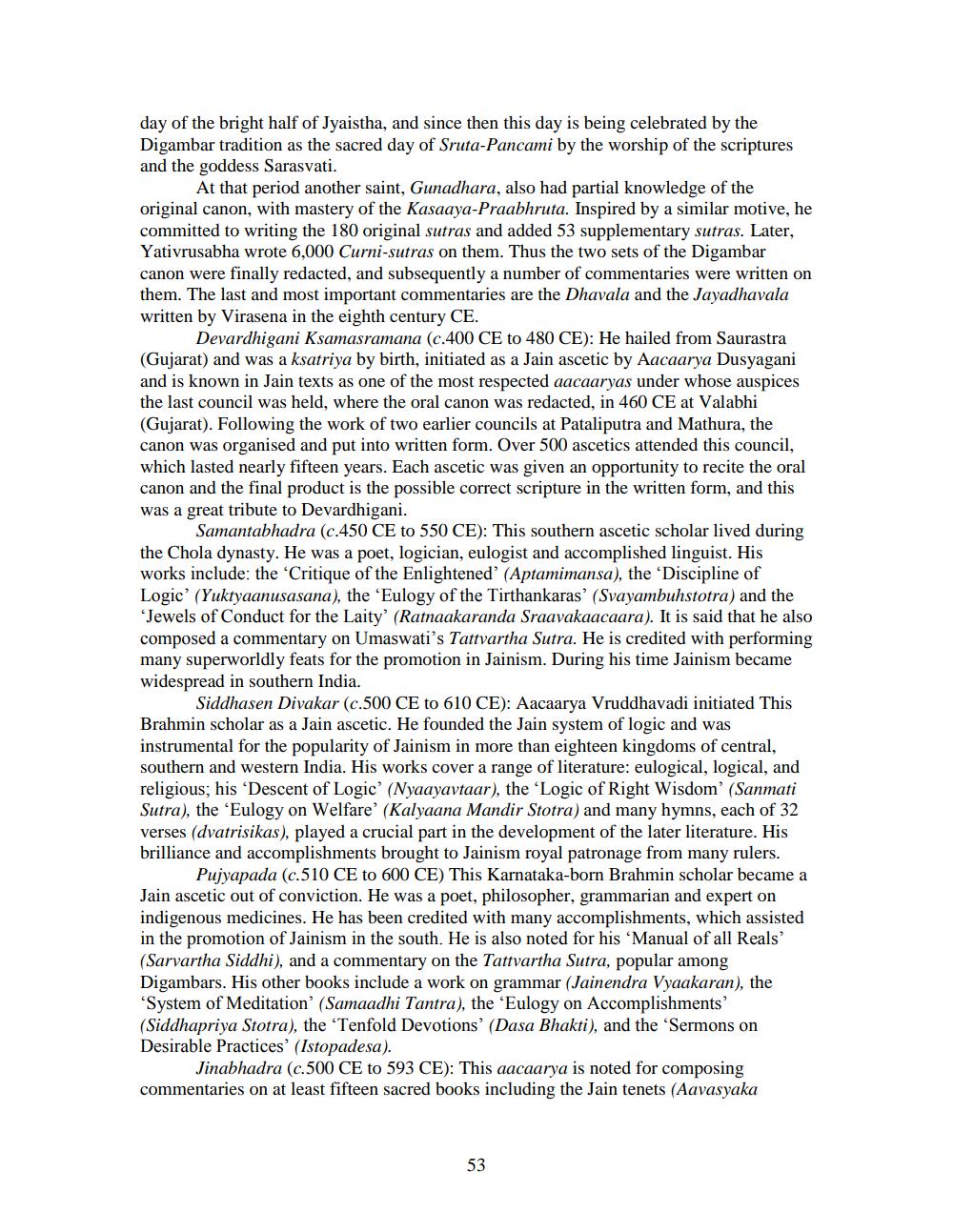________________
day of the bright half of Jyaistha, and since then this day is being celebrated by the Digambar tradition as the sacred day of Sruta-Pancami by the worship of the scriptures and the goddess Sarasvati.
At that period another saint, Gunadhara, also had partial knowledge of the original canon, with mastery of the Kasaaya-Praabhruta. Inspired by a similar motive, he committed to writing the 180 original sutras and added 53 supplementary sutras. Later, Yativrusabha wrote 6,000 Curni-sutras on them. Thus the two sets of the Digambar canon were finally redacted, and subsequently a number of commentaries were written on them. The last and most important commentaries are the Dhavala and the Jayadhavala written by Virasena in the eighth century CE.
Devardhigani Ksamasramana (c.400 CE to 480 CE): He hailed from Saurastra (Gujarat) and was a ksatriya by birth, initiated as a Jain ascetic by Aacaarya Dusyagani and is known in Jain texts as one of the most respected aacaaryas under whose auspices the last council was held, where the oral canon was redacted, in 460 CE at Valabhi (Gujarat). Following the work of two earlier councils at Pataliputra and Mathura, the canon was organised and put into written form. Over 500 ascetics attended this council, which lasted nearly fifteen years. Each ascetic was given an opportunity to recite the oral canon and the final product is the possible correct scripture in the written form, and this was a great tribute to Devardhigani.
Samantabhadra (c.450 CE to 550 CE): This southern ascetic scholar lived during the Chola dynasty. He was a poet, logician, eulogist and accomplished linguist. His works include: the 'Critique of the Enlightened' (Aptamimansa), the 'Discipline of Logic" (Yuktyaanusasana), the "Eulogy of the Tirthankaras' (Svayambuhstotra) and the 'Jewels of Conduct for the Laity' (Ratnaakaranda Sraavakaacaara). It is said that he also composed a commentary on Umaswati's Tattvartha Sutra. He is credited with performing many superworldly feats for the promotion in Jainism. During his time Jainism became widespread in southern India.
Siddhasen Divakar (c.500 CE to 610 CE): Aacaarya Vruddhavadi initiated This Brahmin scholar as a Jain ascetic. He founded the Jain system of logic and was instrumental for the popularity of Jainism in more than eighteen kingdoms of central, southern and western India. His works cover a range of literature: eulogical, logical, and religious; his 'Descent of Logic' (Nyaayavtaar), the 'Logic of Right Wisdom' (Sanmati Sutra), the 'Eulogy on Welfare' (Kalyaana Mandir Stotra) and many hymns, each of 32 verses (dvatrisikas), played a crucial part in the development of the later literature. His brilliance and accomplishments brought to Jainism royal patronage from many rulers.
Pujyapada (c.510 CE to 600 CE) This Karnataka-born Brahmin scholar became a Jain ascetic out of conviction. He was a poet, philosopher, grammarian and expert on indigenous medicines. He has been credited with many accomplishments, which assisted in the promotion of Jainism in the south. He is also noted for his 'Manual of all Reals' (Sarvartha Siddhi), and a commentary on the Tattvartha Sutra, popular among Digambars. His other books include a work on grammar (Jainendra Vyaakaran), the "System of Meditation' (Samaadhi Tantra), the 'Eulogy on Accomplishments' (Siddhapriya Stotra), the 'Tenfold Devotions' (Dasa Bhakti), and the 'Sermons on Desirable Practices' (Istopadesa).
Jinabhadra (c.500 CE to 593 CE): This aacaarya is noted for composing commentaries on at least fifteen sacred books including the Jain tenets (Aavasyaka
53




